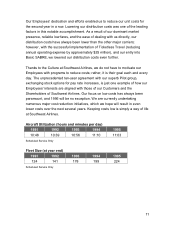Southwest Airlines 1995 Annual Report Download - page 21
Download and view the complete annual report
Please find page 21 of the 1995 Southwest Airlines annual report below. You can navigate through the pages in the report by either clicking on the pages listed below, or by using the keyword search tool below to find specific information within the annual report.21
Management’s Discussion And Analysis Of Financial Condition And Results Of
Operations
Year In Review
Southwest and the airline industry posted their highest profits ever in 1995. Southwest began
1995 with first quarter earnings substantially below first quarter 1994. This beginning of 1995
followed a 47 percent decline in fourth quarter 1994 earnings compared to fourth quarter 1993. In
early 1995, we addressed many of the challenges that surfaced during fourth quarter 1994, and
we finished the year strong, reporting record earnings for 1995.
Competitive pressures eased in 1995 with most carriers pulling back to their hubs and routes
where they dominate. Continental Lite ceased to exist, American substantially decreased its
presence in Nashville, and the United Shuttle reduced head-to-head competition with Southwest
by approximately 50 percent. Southwest, however, continued to expand, adding service to
Omaha, Nebraska, and increasing service in many under-served markets, particularly those
experiencing reductions in service by other carriers.
In 1995, capacity and traffic for the domestic airline industry grew approximately three percent
and four percent, respectively, and load factor increased versus 1994 due to modest capacity
growth and a steady economy. Southwest, however, grew capacity aggressively at 12.6 percent.
For most of 1995 and in January 1996, Southwest’s monthly load factors were below year-ago
levels. While it is too early to determine if this trend will continue in 1996, thus far the lower load
factors have been offset by strong passenger revenue yield performances. Our passenger
revenue yield for January 1996 exceeded January 1995 by more than ten percent aided, in large
measure, by the lapse of the ten percent federal ticket tax on January 1, 1996.
The early results of our 1996 expansion into Florida look promising as our load factors for our
initial two markets, Tampa and Ft. Lauderdale, have exceeded our systemwide averages. We
will begin service to Orlando in April 1996.
After years of horrendous losses, most carriers reduced costs in 1995 by closing hubs, reducing
their work force, contracting high-cost work, and obtaining concessions from union workers. For
the second consecutive year, our operating expenses per available seat mile (ASM) also
declined year-over-year, down .1 percent in 1995 primarily due to the significant reduction in the
Company’s distribution costs. While our goal is to continue this overall cost trend, recent
increases in jet fuel prices, and the October 1, 1995 implementation of a 4.3 cents per gallon
transportation fuel tax for
commercial aviation, make near-term reductions in total operating expenses on a per-ASM basis
much more difficult.
The national budget impasse, lapse of the ten percent ticket tax and its presumed reinstatement,
proposed deferral of the jet fuel tax, and looming prospect of FAA reform present uncertainty for
1996 and future periods. At the current time, Southwest is unable to predict how these issues will
be resolved and what impact, if any, resolution of these uncertainties will have on future
operating results or financial condition.
During 1996, we plan to add a net of seventeen aircraft to our fleet, which will be used primarily
in our Florida expansion and to strengthen our existing route system.
RESULTS OF OPERATIONS
1995 COMPARED WITH 1994 The Company’s consolidated net income for 1995 was $182.6
million ($1.23 per share), as compared to the corresponding 1994 amount of $179.3 million
($1.22 per share), an increase of 1.8 percent.
























